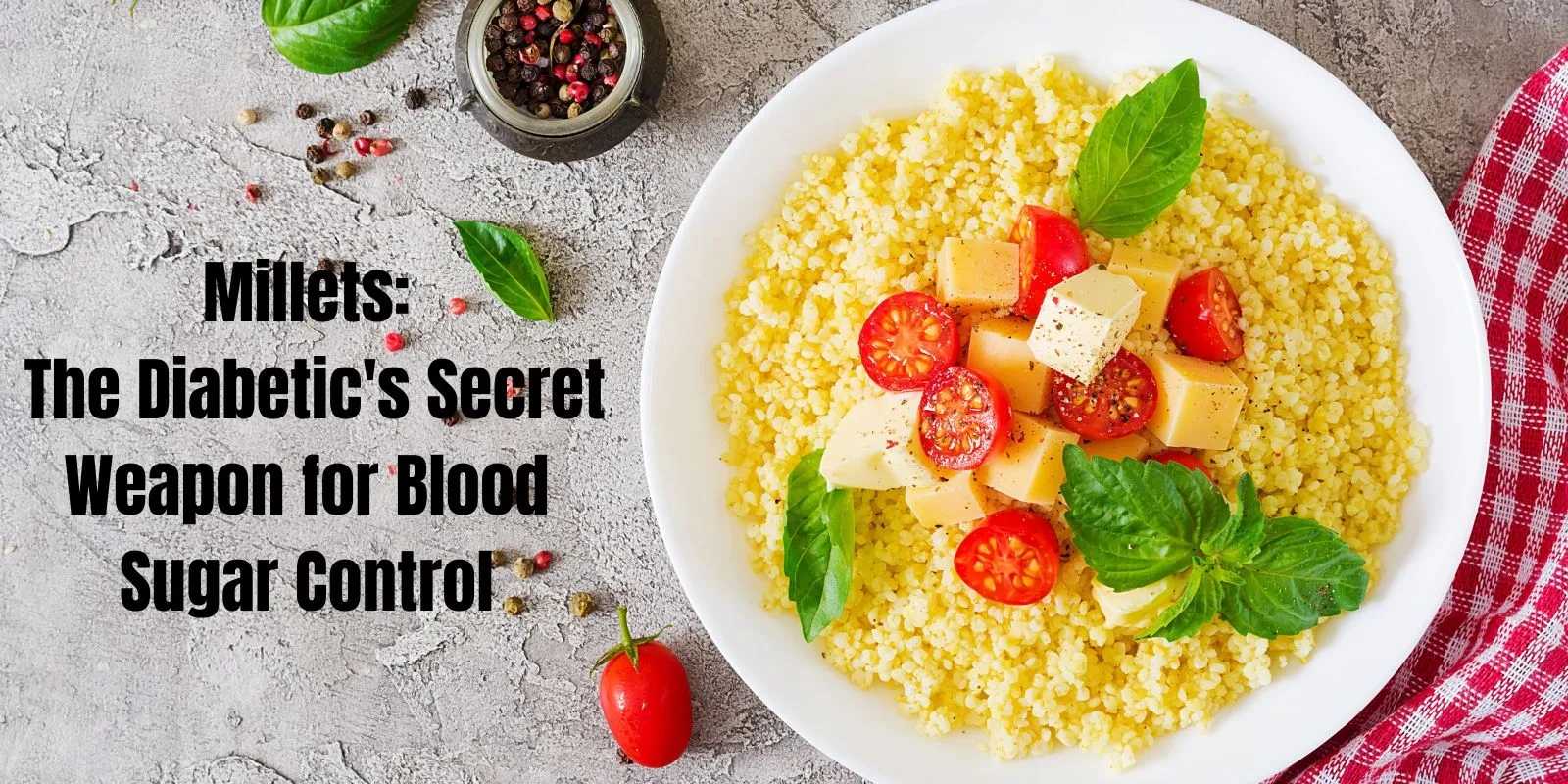
The Diabetic’s Secret Weapon for Blood Sugar Control

Millets:
The Diabetic’s Secret Weapon for Blood Sugar Control
Millets, the tiny nutritional powerhouses, are gaining well-deserved recognition for their health benefits. But for diabetics, millets offer a game-changing advantage – blood sugar management. Here’s why millets deserve a permanent spot on your diabetic diet
1. Low Glycaemic Index (GI) Champion:
Unlike rice and refined wheat, millets boast a low to moderate GI score. This means they release glucose slowly, preventing those dreaded blood sugar spikes. This sustained release keeps you energized and your blood sugar levels under control.
2. Fiber Powerhouse for Steady Blood Sugar:
Millets are packed with dietary fibre, which slows down carbohydrate digestion and sugar absorption. This gentle rise in blood sugar is ideal for diabetics, promoting better blood sugar control.
3. Rich in Protein and Healthy Fats:
Protein and healthy fats like those found in millets also contribute to steadier blood sugar levels. They promote satiety, keeping you feeling fuller for longer and preventing cravings for sugary treats.
4. Treasure Trove of Essential Nutrients:
Millets are a powerhouse of essential vitamins and minerals like magnesium, phosphorus, and B-complex vitamins. These nutrients play a crucial role in insulin sensitivity and overall health, which is vital for diabetes management.
5. Gluten-Free Goodness:
For diabetics with gluten sensitivity, millets are a godsend. They are naturally gluten-free, making them a safe and healthy grain option.
Millet Varieties for Your Diabetic Diet:
- Foxtail Millet: Known for its particularly low GI, foxtail millet is a perfect choice for blood sugar control.
- Pearl Millet (Bajra): Rich in fibre and with a moderate GI, bajra helps with satiety and blood sugar management.
- Finger Millet (Ragi): Though with a slightly higher GI, ragi is packed with protein, calcium, and fibre, making it a well-rounded diabetic superfood.
- Khapli Atta: While not technically a millet, khapli wheat shares many benefits for diabetics. It boasts a low glycaemic index and is high in fibre, promoting steady blood sugar levels. Please note: Khapli atta contains gluten, so it’s not suitable for diabetics with gluten sensitivity.
- Barnyard Millet: An excellent source of protein and dietary fibre, barnyard millet has a very low glycaemic index. It’s also a good source of iron and B vitamins.
- Little Millet: With a slightly sweet and nutty flavour, little millet is another good source of protein and fibre. It also contains a good amount of calcium, iron, and magnesium.
- Proso Millet: Proso millet is a good source of protein and fibre, and it also contains some iron and B vitamins. It has a slightly higher glycaemic index than some other millets, but it’s still a good option for people with diabetes.
- Sorghum Millet (Jowar): Sorghum millet is a good source of protein, fibre, and antioxidants. It has a moderate glycaemic index, making it a good choice for people with diabetes who are looking for a versatile grain.
How to Include Millets in Your Diabetic Diet
Millets are incredibly versatile! Here are some ideas:
- Roasted Millet Nuts and Seeds Mix: Roast foxtail millet with almonds, walnuts, and pumpkin seeds for a crunchy and protein-packed snack. Season with a hint of cinnamon for extra flavour.
- Millet Veggie Fritters: Combine cooked millet with mashed vegetables like grated carrots, chopped onions, and coriander. Add a pinch of turmeric and cumin for extra taste. Pan-fry for a healthy and satisfying snack.
- Spiced Millet Crackers: Make your own crackers using millet flour. Add herbs like rosemary and thyme for a flavourful twist. Bake until crisp and enjoy with a homemade yogurt dip.
- Millet Energy Bars: Combine cooked millets with mashed bananas, chopped nuts, and a drizzle of honey for a naturally sweet and energy-boosting bar.
- Swapped Staples: Replace rice or refined wheat with millets in your meals. Try millet pilaf, khichdi, or millet rotis.
- Millet Porridge: A wholesome breakfast option, millet porridge keeps you feeling full and energized.
- Millet Salads: Add cooked millets to salads for a boost of fibre and complex carbohydrates.
Remember:
While millets and khapli atta are great diabetic food choices, consult your doctor or a registered dietitian for a personalized diabetic meal plan.



 Free Shipping on Order above ₹499/-
Free Shipping on Order above ₹499/- 

